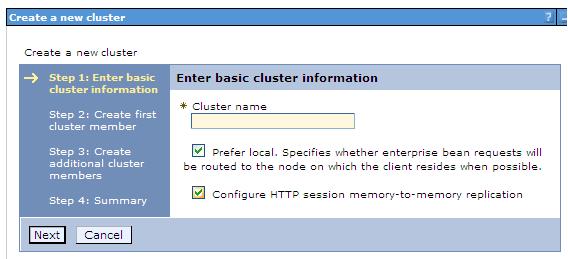Replicate data across appservers in a cluster
Overview
Use this task to configure a data replication domain in a cluster for...
Data replication domains utilize the data replication service (DRS).
Use replication to...
- Prevent loss of session data with session manager
- Improve the performance of the dynamic cache service
- Provide failover in stateful session beans.
If when creating a cluster, you select the option...
Configure HTTP memory-to-memory replication...the replication domain is automatically created for you.
Procedure
- Use one of the following methods to create a replication domain:
- Create a replication domain manually...
Environment | Replication domains | New

On this page you can specify the properties for the replication domain, including...
- timeout
- encryption
- number of replicas
- Create a replication domain when you create a cluster...
Servers | Clusters | New | Configure HTTP memory-to-memory replication

The replication domain that is created has the same name as the cluster and has the default settings for a replication domain. The default settings for a replication domain are to create a single replica of each piece of data and to have encryption disabled. To modify the replication domain properties, click...
Environment | Replication domains | replication_domain_name

- Create a replication domain manually...
- Configure replication domain consumers for...
Each type of consumer must be configured with a different replication domain. For example, session manager uses one domain and dynamic cache uses a different replication domain.
Use one replication domain if you are configuring session manager and stateful session bean replication. This ensures that the backup state information of HTTP sessions and stateful session beans are on the same appservers.
- Determine whether the configuration requires additional thread resources.
The replication service uses threads obtained from the default thread pool for various tasks, including processing messages. Other appserver components also use this thread pool. Therefore, during appserver startup the default maximum thread pool size of 20 might not be sufficient to allow the replication service to obtain enough threads from the pool to process all of the incoming replication messages. The number of incoming messages is influenced by the number of appservers in the domain and the number of replication domain consumers on each appserver. The number of messages to be processed increases as the number of appservers in the domain increases and/or the number of replication consumers increases.
Persistent data not being replicated to the appservers during server startup might be an indication that increase the setting for the maximum thread pool size. In larger configurations, doubling the maximum size of the Default thread pool to 40 is usually sufficient. However, if the number of appservers in a replication domain is greater ten and the number of replication domain consumers in each appserver is greater than two, it might have to set the maximum thread pool size to a value greater than 40.
Results
Data is replicating among the appservers in a configured replication domain.
What to do next
If you select DES or 3DES as the encryption type for a replication domain, an encryption key is used for the encryption of messages. At regular intervals, for example once a month, you should go to...
Environment | Replication domains
...in the console, and click Regenerate encryption key to regenerate the key. After the key is regenerated, restart all of the appservers that are configured as part of the replication domain. Periodically regenerating the key improves data security.
Replication
Replication domain collection
Migrating servers from multi-broker replication domains to data replication domains
Replicating data with a multi-broker replication domain